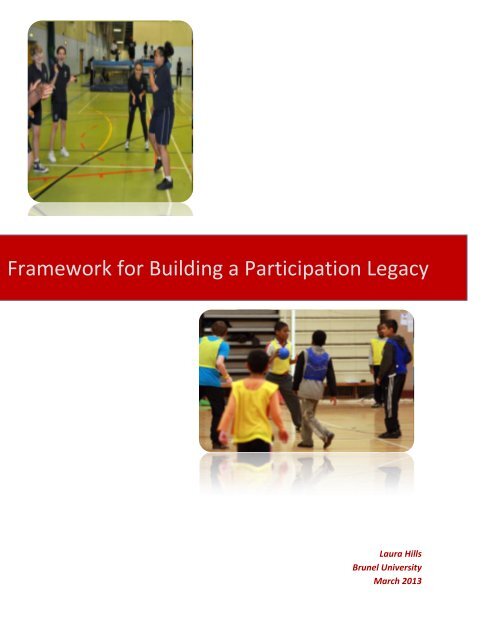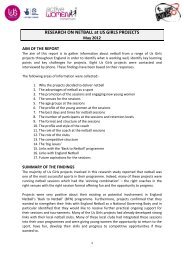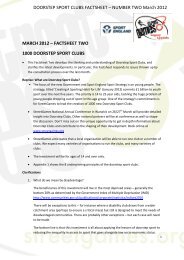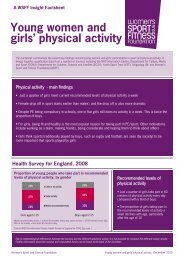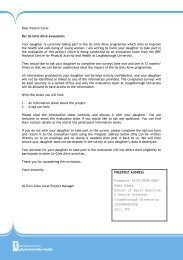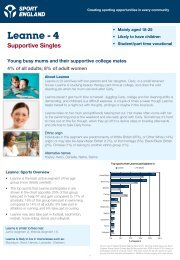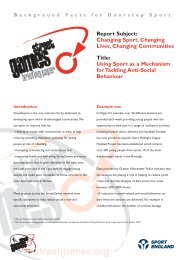Framework for Building a Participation Legacy - StreetGames
Framework for Building a Participation Legacy - StreetGames
Framework for Building a Participation Legacy - StreetGames
Create successful ePaper yourself
Turn your PDF publications into a flip-book with our unique Google optimized e-Paper software.
<strong>Framework</strong> <strong>for</strong> <strong>Building</strong> a <strong>Participation</strong> <strong>Legacy</strong><br />
Laura Hills<br />
Brunel University<br />
March 2013
<strong>Framework</strong> <strong>for</strong> <strong>Building</strong> a <strong>Participation</strong> <strong>Legacy</strong><br />
1<br />
Forward<br />
This framework provides a resource <strong>for</strong><br />
creating a participation legacy <strong>for</strong> young<br />
people from disadvantaged backgrounds.<br />
The <strong>StreetGames</strong> <strong>Legacy</strong> projects were<br />
designed to provide young people with<br />
inspiring sporting opportunities using the<br />
doorstep approach, be<strong>for</strong>e, during and after<br />
London 2012. This framework is based on<br />
the findings from this initiative as well as<br />
other relevant resources.<br />
The framework is designed <strong>for</strong> programme coordinators, managers, and practitioners working in<br />
deprived communities. It sets out considerations <strong>for</strong> planning and conducting evaluations with<br />
the goal of helping to incorporate mega-events into programme planning, delivery, and<br />
evaluation.<br />
One of the tenets of this guide is the understanding that mega-events themselves do not<br />
automatically lead to increased sports participation. Young people may enjoy watching sporting<br />
spectacles, feel inspired by per<strong>for</strong>mances, and experience social connectedness during the<br />
event; however, these experiences will not necessarily lead to behaviour change unless support<br />
structures are put in place that link the ‘feel good’ factor of Olympic and Paralympic sport with<br />
desirable local opportunities. The <strong>Legacy</strong> projects that <strong>for</strong>m the basis <strong>for</strong> this framework<br />
focused on increasing opportunities <strong>for</strong> sports participation while drawing on some of the<br />
enthusiasm, publicity, and spirit generated by the games.<br />
This framework addresses the following components of building a participation legacy:<br />
<br />
<br />
<br />
<br />
<br />
Mega-events and participation<br />
Planning<br />
Developing aims, objectives, and outcome indicators<br />
Approaches to and methods of evaluation<br />
An evaluation checklist<br />
March 2013
<strong>Framework</strong> <strong>for</strong> <strong>Building</strong> a <strong>Participation</strong> <strong>Legacy</strong><br />
2<br />
Contents<br />
Forward .......................................................................... 1<br />
Contents ......................................................................... 2<br />
How can a mega event help increase participation? ..... 3<br />
Why Evaluate? ................................................................ 4<br />
Planning the Evaluation .................................................. 5<br />
Programme Aims ............................................................ 5<br />
Objectives ....................................................................... 6<br />
Population ...................................................................... 7<br />
Approaches to Evaluation .............................................. 9<br />
Methods of Evaluation ................................................. 10<br />
Evaluation Checklist ...................................................... 12<br />
Notes <strong>for</strong> Evaluation Checklist ..................................... 13<br />
Conclusion .................................................................... 18<br />
References .................................................................... 19<br />
Resources on Evaluation .............................................. 19<br />
March 2013
<strong>Framework</strong> <strong>for</strong> <strong>Building</strong> a <strong>Participation</strong> <strong>Legacy</strong><br />
3<br />
What is a <strong>Participation</strong> <strong>Legacy</strong>?<br />
The London2012 legacy action plan included the<br />
promise “Make the UK a world-leading sporting<br />
nation”. Community sport broadly and <strong>StreetGames</strong><br />
specifically were designated as crucial to fulfilling<br />
legacy ambitions of inspiring young people through<br />
sport and getting people more active.<br />
The participation legacy, there<strong>for</strong>e, focused on<br />
enhancing and increasing opportunities <strong>for</strong> engaging<br />
in quality sport from grassroots to elite levels.<br />
Increasing participation has been shown to be<br />
challenging and there was little increase in<br />
participation figures in England in the two decades<br />
prior to London 2012. The British government was<br />
aware from the beginning that a participation legacy<br />
would not occur without specific, focused ef<strong>for</strong>ts.<br />
‘‘There is nothing inevitable or Godgiven<br />
about the legacy of the 2012<br />
Games”.<br />
(Tessa Jowell, <strong>for</strong>mer Culture, Media<br />
and Sport Secretary and Olympic<br />
Minister)<br />
Increases in participation require substantial resource<br />
and planning as well as an ability to tackle the<br />
complex combination of factors that shape individual<br />
decisions to initiate and sustain participation in sport.<br />
How can a mega event help increase participation?<br />
Examples of linking to mega-event<br />
activities<br />
Mega-events do not automatically influence mass<br />
participation; however, the publicity, excitement,<br />
attention to sport, festival-like qualities, and inspiration that they can generate have been used<br />
to develop and enhance sports delivery (Weed, Coren,& Fiore, 2009). Conceptually, the links<br />
between mega sports events and participation include:<br />
<br />
<br />
<br />
<br />
<br />
Joining with national initiatives<br />
Joining with local partners such as<br />
schools, colleges, charities, and<br />
local authorities to host events<br />
Link provision to festival activities<br />
giving a young people a chance to<br />
try the sport and meet people<br />
(local, club, university, elite) who<br />
play it regularly<br />
Mega-sports related tournament<br />
Sports-related activities such as<br />
‘back to netball’<br />
Develop taster programmes that<br />
include a series of free sessions in<br />
local indoor/outdoor venues that<br />
are free with no advance booking<br />
<br />
<br />
<br />
Taster sessions of mega-sport<br />
events to existing groups<br />
Fitness activities linked to broader<br />
values of activity associated with<br />
the mega-event<br />
Combinations of local and regional<br />
activities to increase interactions<br />
between communities<br />
<br />
<br />
<br />
Mega sports events may inspire already active participants to increase participation or<br />
to try new activities. This trickle-down approach does not work <strong>for</strong> everyone and needs<br />
to be supported through community initiatives.<br />
The festival-like atmosphere of mega sports events may encourage active and less active<br />
members of the population to get involved in local activities linked to this festive spirit.<br />
The appearance of new sports on the sporting landscape may create an interest in trying<br />
these activities.<br />
March 2013
<strong>Framework</strong> <strong>for</strong> <strong>Building</strong> a <strong>Participation</strong> <strong>Legacy</strong><br />
4<br />
<br />
<br />
<br />
Mega sports events may help to foster a sense of community and social connectedness<br />
that facilitate individuals’ willingness to get involved in local sport as a participant,<br />
volunteer, or coach.<br />
The creation of new local facilities may increase opportunities <strong>for</strong> access to attractive,<br />
dedicated sporting spaces.<br />
In<strong>for</strong>mation and knowledge about sporting opportunities may be increased.<br />
Most importantly, the use of mega sport events needs to be part of more comprehensive<br />
community-based initiatives (Girginov & Hills, 2008). Most programmes are delivered by<br />
drawing on the enthusiasm a mega-event can generate to offer new opportunities <strong>for</strong><br />
participation, to attract new people, and to enhance current provision. For example, Smith and<br />
Fox (2007) discuss the value of event-themed rather than event-led activities which are<br />
embedded in community values and local partnerships rather than focusing on sports fans and<br />
supporters.<br />
Why Evaluate?<br />
Evaluation of community youth sport typically focuses on<br />
how particular programmes work. This provides a basis <strong>for</strong><br />
understanding what elements lead to desired changes and<br />
what aspects of a programme might need to be improved.<br />
Evaluation can be done quite quickly to understand and<br />
address specific problems or over a longer period to assess<br />
whether a programme is leading to change.<br />
Evaluations of community sport may also be done to help<br />
demonstrate how a programme is positively impacting<br />
young people’s lives as a basis to support funding or<br />
marketing ef<strong>for</strong>ts. Impact-based evaluation is designed to<br />
show change related to a particular intervention which can<br />
again be used to demonstrate the effectiveness of a<br />
programme and to illustrate what is working and why, as<br />
well as what might need to be improved.<br />
‘The purpose of an evaluation is to<br />
assess the effects and effectiveness<br />
of something, typically some<br />
innovation or intervention, policy,<br />
practice or service’<br />
(Robson, 1993: 170)<br />
Evaluation helps to...<br />
<br />
<br />
<br />
<br />
<br />
<br />
<br />
<br />
Improve programmes<br />
Gain understanding of<br />
participant’s views of<br />
programmes<br />
Involve participants in service<br />
design<br />
Demonstrate whether an<br />
activity is helpful<br />
Examine particular features of<br />
a programme such as<br />
coaching, volunteer<br />
experience, benefits<br />
Provide process based<br />
in<strong>for</strong>mation that allows <strong>for</strong><br />
refining practices during a<br />
project<br />
Demonstrate impact <strong>for</strong><br />
funders and stakeholders<br />
Provide in<strong>for</strong>mation <strong>for</strong><br />
quality assurance<br />
March 2013
<strong>Framework</strong> <strong>for</strong> <strong>Building</strong> a <strong>Participation</strong> <strong>Legacy</strong><br />
5<br />
Planning the Evaluation<br />
The evaluation strategy should be incorporated into the planning of the programme or<br />
intervention. This includes consideration of what your programme is designed to do, what<br />
factors will illustrate whether it has been effective, or what factors will help you understand<br />
‘what is working’? Most importantly, the evaluation should reflect the aims and objectives of<br />
the programme.<br />
Programme Aims<br />
Aims are broad statements about the overall goals of the programme. They are typically<br />
developed in relation to particular community needs and are usually initiated during a period of<br />
planning and consultation where resources, facilities, and target population are considered.<br />
Sports programmes often incorporate a combination of sport and non-sport related aims that<br />
shape the planning, delivery, and evaluation. Aligning evaluation with aims and objectives will<br />
help to clarify what will indicate success.<br />
Sport-related aims are often related to participation and progression. Common sport-related<br />
aims <strong>for</strong> community-based programmes <strong>for</strong> young<br />
people would be to:<br />
‣ Increase physical activity levels of young people<br />
from socially disadvantaged backgrounds<br />
‣ Introduce new sporting opportunities <strong>for</strong> young<br />
people<br />
‣ Increase opportunities <strong>for</strong> progression<br />
‣ Increase numbers of peer mentors, volunteers, and<br />
coaches<br />
‣ Encourage more individuals to attain qualifications<br />
‣ Develop programmes to attract greater numbers of<br />
inactive young people<br />
Non-sporting aims may be incorporated as part of<br />
sports initiatives <strong>for</strong>mally or in<strong>for</strong>mally. Non-sporting<br />
aims that have often been linked to <strong>StreetGames</strong> and<br />
other community-based programmes <strong>for</strong> young people include:<br />
‣ Improve health<br />
‣ Improve pro-social skills such as helping behaviours<br />
‣ Increase social affiliation through social capital, cohesion or citizenship<br />
‣ Develop career-related skills such as time management, leadership,<br />
‣ Reduce anti-social behaviour<br />
‣ Address inequalities in opportunities<br />
‣ Improve psychological factors such as confidence and self-esteem<br />
‣ Increase sports citizenship or sporting capital<br />
‘The setting of aims and<br />
objectives and related,<br />
measurable, per<strong>for</strong>mance<br />
targets is central to the<br />
allocation of resources, the<br />
process of programme design<br />
and management and the<br />
monitoring and evaluation of<br />
per<strong>for</strong>mance.’<br />
(Coalter, 2008:13)<br />
March 2013
<strong>Framework</strong> <strong>for</strong> <strong>Building</strong> a <strong>Participation</strong> <strong>Legacy</strong><br />
6<br />
Objectives<br />
Objectives are more specific than aims and provide a template <strong>for</strong> how aims will be achieved.<br />
Clear objectives will help programme coordinators assess progress towards aims, provide a<br />
blueprint <strong>for</strong> reaching aims, and highlight areas that may need more work.<br />
Sports programmes typically incorporate objectives that support increased physical activity<br />
provision such as initiating programmes or activities designed to initiate and sustain<br />
participation as well as addressing the causes of inactivity within communities. Objectives can<br />
also be related to factors that pre-dispose individuals to be active such as increasing activityrelated<br />
skills and knowledge or enhancing self-confidence about participation.<br />
SMART Objectives<br />
Useful objectives are typically SMART objectives.<br />
Specific: Clear outline of a specific action or activity that will help to achieve the aim.<br />
Measurable: It should be evident whether an objective has been accomplished or not. This<br />
will help to assess progress and to establish the effectiveness of the objective.<br />
Attainable: Objectives need to be realistic and doable. Workers need to understand how to<br />
implement the objective.<br />
Relevant: The objective needs to match up to the aim. It may also be necessary to link an<br />
objective to an aspect of the mega-event if that is deemed important <strong>for</strong> the programme.<br />
Timely: The objective needs to be implemented in a timely manner that will enable aims to<br />
be met. (adapted from Coalter, 2008)<br />
Outcome Indicators<br />
The evaluation of activities associated with mega-events should be incorporated into the overall<br />
aims and objectives of programmes. Outcome indicators represent measurable targets that<br />
demonstrate whether you are achieving your aims and objectives.<br />
Outcome indicators related to measuring increases in activity levels often focus on factors such<br />
as: frequency, time, intensity, and type. (Cavill, Roberts, & Rutter, 2012: 9). Frequency refers to<br />
how often someone takes part, time includes the amount of time spent engaging in activities,<br />
intensity focuses on the level of exertion, and type refers to the activity.<br />
March 2013
<strong>Framework</strong> <strong>for</strong> <strong>Building</strong> a <strong>Participation</strong> <strong>Legacy</strong><br />
7<br />
Outcome indicators can also support activities designed to market and recruit. For example,<br />
creating opportunities to allow your target group to learn about or try your programme.<br />
Indicators can also relate to factors that may be improved through participation such as<br />
individual attitudes, knowledge, or approach to sport or indicators of enhanced social skills.<br />
Population<br />
In addition to aims and objectives, population plays a key role in planning programmes and<br />
evaluation. <strong>StreetGames</strong> programmes focus on young people from socially disadvantaged<br />
backgrounds and activities are designed using the ‘doorstep sport’ approach. Socially<br />
disadvantaged young people constitute a diverse group and programmes can be further tailored<br />
to meet their different needs and interests.<br />
Interest and experience in sport<br />
<br />
<br />
Gender<br />
<br />
<br />
<br />
<br />
<br />
Young people who are active already or who have positive associations with sport will<br />
be more motivated to participate, will potentially have more interest in and<br />
identification with mega sports events.<br />
Young people who have had negative experiences of sports, who have limited<br />
knowledge of sport, who may not have an interest in sporting events, and who are less<br />
active will be more effectively recruited through programmes that they perceive as fun,<br />
and designed with their interests in mind. They may initially have less affiliation with<br />
mega sporting events.<br />
Young women have been identified as a group with lower participation rates than their<br />
male peers. Often community sports programmes are more successful at attracting<br />
males and different approaches may be required to recruit young women. Particularly<br />
young women who feel that they are not sporty and who are less experienced.<br />
Young women may be less likely to identify as sports fans and to spend time spectating<br />
sport or engaging in consumption based activities such as reading or conversing about<br />
sport. Mega-sports events are often perceived as different from typical sporting events<br />
and it may be possible to generate and build on their broader appeal.<br />
Sporty young women may be happy to join in mixed gender activities and may be<br />
motivated by the same marketing styles as boys. However, many young women prefer<br />
female-only sports activities. This may be due to religious reasons, but it may also relate<br />
to previous negative mixed sport experiences. Developing new programmes designed to<br />
recruit less active girls and women may need to be delivered as girls’ only spaces, at<br />
least initially.<br />
Sporty young men may be highly motivated by mega-events. They may, however, need<br />
more encouragement to try less traditional sports.<br />
Non-sporty young men may enjoy opportunities to try new sporting activities rather<br />
than traditional sports where they may have experienced less success.<br />
Social Disadvantage<br />
<br />
Streetgames’ doorstep sport approach has a proven track record of meeting the needs of<br />
young people from disadvantaged backgrounds. It brings sports to communities ‘where<br />
March 2013
<strong>Framework</strong> <strong>for</strong> <strong>Building</strong> a <strong>Participation</strong> <strong>Legacy</strong><br />
8<br />
<br />
<br />
they want it, at times when they want it and in a style they want’. This reflects a desire to<br />
circumvent traditional barriers to young people’s involvement such as concerns about<br />
safety, expense, travel, activity choice, experience, adult support, familiarity with the<br />
environment, and knowledge of activities.<br />
Young people from disadvantaged backgrounds may be less able to af<strong>for</strong>d to attend mega<br />
sports events and may feel relatively disaffected by the events. Finding ways to link mega<br />
events to relevant, community identities may help with recruiting.<br />
Some young people from socially disadvantaged backgrounds may be wary about joining<br />
groups or trying new activities. Particularly if these activities are not valued by their peer<br />
group because they are perceived as too <strong>for</strong>mal, or childish, or not ‘cool’.<br />
Ethnicity, religion and culture<br />
<br />
<br />
<br />
Ethnicity, religion and culture can play a role in young people’s decisions to participate<br />
in sport. Research indicates that consultation with local community groups can facilitate<br />
understanding of a particular group’s needs and interests and enhance the likelihood<br />
that young people will be encouraged to attend. The need <strong>for</strong> parental or community<br />
support may be particularly important <strong>for</strong> young women.<br />
Religion has been shown to be particularly influential <strong>for</strong> young people from a Muslim<br />
background. Activities may need to be scheduled so they are compatible with religious<br />
and domestic commitments.<br />
Linking mega-events to local cultures may facilitate engagement and excitement.<br />
Age<br />
<br />
Age can play a factor in recruiting and many community organizations have found it<br />
more difficult to engage young people over the age of 16. Including young people in<br />
programme planning, providing separate activities <strong>for</strong> 16+, and providing opportunities<br />
<strong>for</strong> volunteering, training, and other CV-enhancing activities can be motivating to this<br />
group.<br />
Sports Festival<br />
One successful Sport Festival aimed at providing<br />
Muslim women with in<strong>for</strong>mation about local sports<br />
sessions used an Olympic style <strong>for</strong>mat <strong>for</strong> the<br />
activities. Participants were encouraged to try all<br />
events and medals were given to participants <strong>for</strong> their<br />
differing achievements. In addition, some women won<br />
tickets to Olympic events. The success of an Olympicthemed<br />
festival could be evaluated by attendance, by<br />
people’s feedback on the day, and by future uptake by<br />
festival participants.<br />
March 2013
<strong>Framework</strong> <strong>for</strong> <strong>Building</strong> a <strong>Participation</strong> <strong>Legacy</strong><br />
9<br />
Approaches to Evaluation<br />
Evaluation can occur be<strong>for</strong>e, during and after your programme begins. This means that<br />
evaluation should be part of the planning of your programme in order to allow time <strong>for</strong> pre-test<br />
or baseline measures. In addition, planning your evaluation early helps to ensure that the design<br />
of the evaluation fits the aims and objectives of your programme.<br />
Impact Evaluation<br />
•Typically employs a pre/post design<br />
•Most commonly used to demonstrate the effectiveness of an intervention<br />
designed to change behaviours, attitudes, knowledge, or skill<br />
Process or Formative Evaluation<br />
•Provides insight into 'what is happening?'<br />
•Helps to explain and contextualise outcome and impact findings<br />
•Provides opportunities to modify programmes<br />
Outcome Evaluation<br />
•Focuses on understanding the effects of the programme<br />
•Useful when establishing a baseline or conducting a pre-test is not feasible or<br />
desirable<br />
Impact evaluation investigates specific changes that result from a programme or intervention.<br />
In an impact evaluation participants are assessed prior to and at the end of the programme.<br />
Impact evaluations are challenging as it is often difficult to ascertain causal relationships, i.e. be<br />
certain that any changes are due to the programme; however, they can be important <strong>for</strong><br />
demonstrating the value of a programme.<br />
Process evaluation is useful <strong>for</strong> understanding<br />
whether a programme is working, what elements<br />
are working well, and what might need to be<br />
changed.<br />
Outcome evaluation occurs at the end of the<br />
programme and explores how well the programme<br />
met its aims and objectives. It often focuses on<br />
participants’ reports of what happened as well as<br />
more quantitative measures of success related to<br />
attendance or fitness levels.<br />
‘Outcome evaluation alone is not<br />
sufficient as it does not explore the<br />
reasons why an intervention has been<br />
successful. We must ask what, how<br />
and why a sport/physical activity<br />
intervention is successful if the<br />
evaluation is to be meaningful’.<br />
(Dugdill & Stratton, 2007: 5)<br />
March 2013
<strong>Framework</strong> <strong>for</strong> <strong>Building</strong> a <strong>Participation</strong> <strong>Legacy</strong><br />
10<br />
Methods of Evaluation<br />
There are a number of potential evaluation methods that programmes can use depending on<br />
the approach to evaluation.<br />
Pre/Post Methods of Evaluation<br />
Pre/Post Evaluations entails measuring variables of interest be<strong>for</strong>e and after the initiation of a<br />
programme. For <strong>StreetGames</strong> programmes baseline measure will generally entail self-report<br />
surveys comparing levels of activity, skill, knowledge, or attitudes be<strong>for</strong>e and after the<br />
programme. Fitness testing, skill testing, and psychological measures are common pre/post<br />
methods used in research but these typically need to be conducted by specialists and may be<br />
less feasible <strong>for</strong> community programmes to implement. These also need to be considered<br />
carefully as young people may have concerns or be uncom<strong>for</strong>table with fitness testing and or<br />
completing some types of psychological measures.<br />
Process Methods of Evaluation<br />
Process evaluations use a variety of methods to ascertain how well a programme is working and<br />
what could be improved. Process evaluations can include interviews, focus or discussion groups,<br />
surveys, diaries, observations, social media responses, and documents.<br />
Outcome Methods of Evaluation<br />
Outcome evaluations often include the final descriptive data on numbers of people who<br />
engaged in the programme. It also often includes final feedback on participants’ experiences<br />
which may be ascertained through focus groups, discussions, and surveys. Sample Aims,<br />
Objectives, Indicators and Source of In<strong>for</strong>mation<br />
The tables below provide examples of project aims, possible objectives related to the aim,<br />
outcome indicators that represent measurable targets, and the sources of in<strong>for</strong>mation that<br />
might be used to evidence progress. The sources of in<strong>for</strong>mation link to methods of evaluation.<br />
Example 1: Increase Physical Activity <strong>Participation</strong><br />
Aim Objectives Outcome Indicators Sources of In<strong>for</strong>mation<br />
Increase<br />
participation<br />
in physical<br />
Develop free multi-sport<br />
programme based on<br />
event-themes<br />
Number of young<br />
people who attend<br />
sessions<br />
Documents<br />
Number of marketing<br />
sessions<br />
activity<br />
Intensity of<br />
participation in sessions<br />
Number of participants<br />
Records of progression<br />
Market to 3 intact groups<br />
with non-active young<br />
people<br />
Develop partnerships to<br />
support a progression<br />
pathway<br />
<br />
Proportion of young<br />
people who begin other<br />
activities or progress to<br />
other programmes<br />
Self-Report Survey<br />
Level of Exertion<br />
<strong>Participation</strong> in other<br />
activities<br />
PAQ-C, PAQ-A<br />
Observations<br />
Coach records/diary of<br />
intensity<br />
March 2013
<strong>Framework</strong> <strong>for</strong> <strong>Building</strong> a <strong>Participation</strong> <strong>Legacy</strong><br />
11<br />
Example 2: Increase Awareness of Physical Activity Programmes<br />
Aim Objectives Outcome Indicators Sources of In<strong>for</strong>mation<br />
Increase<br />
awareness of<br />
Organise an eventthemed<br />
sports festival<br />
Number of people who<br />
attend festival<br />
Documents<br />
Record of Attendance<br />
physical<br />
activity<br />
Number of people who<br />
attend programmes (i.e.<br />
Record of Visitors to web<br />
page<br />
programmes Distribute incentives <strong>for</strong> use gym passes)<br />
Survey<br />
attendance such as gym<br />
passes<br />
Number of visitors to<br />
the webpage<br />
Participant feedback on<br />
festival and awareness of<br />
Participants’ awareness<br />
of opportunities<br />
activities<br />
Discuss opportunities<br />
<strong>for</strong> participation with<br />
participants<br />
Post on web or social<br />
media<br />
Example 3: Improve Social Cohesion<br />
Focus groups<br />
Participant feedback on<br />
festival and awareness of<br />
activities<br />
Aim Objectives Outcome Indicators Sources of In<strong>for</strong>mation<br />
Improve<br />
social<br />
cohesion<br />
Start an interneighbourhood<br />
basketball<br />
programme<br />
<br />
Documents<br />
Attendance records<br />
Plan opportunities <strong>for</strong><br />
young people to meet<br />
each other<br />
Create opportunities <strong>for</strong><br />
young people to work<br />
together on a project<br />
<br />
<br />
Recruit a number of<br />
young people from<br />
different<br />
neighbourhoods to a<br />
sports programme<br />
Develop a team of<br />
young people from<br />
different<br />
neighbourhoods to<br />
work with staff to plan<br />
programme activities.<br />
Introduce social<br />
activities<br />
Focus Groups or Interviews<br />
Participant perceptions on<br />
social networks within and<br />
outside of programme<br />
Observations<br />
Staff or planning team<br />
diaries<br />
Surveys<br />
On relationships with peers<br />
and staff, changing<br />
attitudes, safety concerns<br />
Example 4: Improve Health<br />
Aim Objectives Outcome Indicators Sources of In<strong>for</strong>mation<br />
Improve<br />
health<br />
Initiate fitness based<br />
programmes such as<br />
Level of exertion<br />
during sessions<br />
Surveys<br />
Self-report measures of selfconfidence,<br />
Zumba or gymwork Increase in fitnessrelated<br />
selfconfidence<br />
changes in<br />
fitness levels and activity,<br />
feelings of health,<br />
Set goals and provide<br />
incentives when they are<br />
reached<br />
Provide instruction on<br />
exercising <strong>for</strong> health<br />
<br />
Progress on fitness<br />
indicators such as<br />
duration, quantity or<br />
level of exertion<br />
knowledge<br />
Questionnaire<br />
Evaluate fitness levels and<br />
progress towards goals each<br />
session<br />
Observations<br />
Staff records of change<br />
March 2013
<strong>Framework</strong> <strong>for</strong> <strong>Building</strong> a <strong>Participation</strong> <strong>Legacy</strong><br />
12<br />
Evaluation Checklist<br />
The Evaluation Checklist is designed to help practitioners go through the stages of designing a<br />
programme that incorporates planning <strong>for</strong> evaluation. It also provides space <strong>for</strong> considering<br />
how the programme will link to a particular mega-event. Notes accompanying the checklist<br />
outline the types of in<strong>for</strong>mation that can facilitate planning and evaluation at each stage of the<br />
process.<br />
Overview of Programme<br />
Completed<br />
1. Title of programme<br />
2. Link to mega-event<br />
3. Programme aims and objectives<br />
4. Rationale <strong>for</strong> programme<br />
5. Funding <strong>for</strong> programme<br />
6. Sponsors/funders interests and requirements<br />
Planning including assessment of resources<br />
7. Facilities and location<br />
8. Staffing<br />
9. Duration of programme including number of<br />
sessions<br />
10. Target population<br />
11. Time of day<br />
12. Activities<br />
13. Cost <strong>for</strong> participants<br />
14. Equipment<br />
15. Cost of delivering programme<br />
16. Organisation and style of delivery?<br />
Evaluation<br />
17. Focus of evaluation<br />
18. Who will conduct the evaluation<br />
19. Methods of evaluation<br />
20. Demographics<br />
21. Timetable of evaluation<br />
a. Pre/Post data<br />
b. Outcome data<br />
c. Process data<br />
22. Analysis<br />
23. Dissemination<br />
Evaluation checklist adapted from Cavill, Roberts and Rutter (2012)<br />
March 2013
<strong>Framework</strong> <strong>for</strong> <strong>Building</strong> a <strong>Participation</strong> <strong>Legacy</strong><br />
13<br />
Notes <strong>for</strong> Evaluation Checklist<br />
1. Title of programme<br />
The name you will use to advertise the specific programme. The title will ideally appeal<br />
to the target population and reflect the aims of the programme.<br />
2. Link to Mega-event<br />
There are many ways to link your programme to mega-events. Consider what elements<br />
of the mega-event will appeal to your target population and be creative. Sometimes a<br />
combination of events is most effective as you can engaged participants who prefer<br />
different types of activities. Examples are provided above and in the resource section<br />
below.<br />
3. Programme Aims and Objectives<br />
Aims help define the broad focus of the programme. What are you trying to achieve<br />
overall? Objectives are more specific indicators of what you will do to reach your aims.<br />
4. Rationale <strong>for</strong> the programme<br />
The rationale is the underpinning evidence <strong>for</strong> how your programme or intervention will<br />
work. The rationale may be based on previous research or indicators that support the<br />
need <strong>for</strong> your programme and the way that you have designed it.<br />
For example, research indicates that young Asian women have lower participation rates<br />
than many of their peers. One of the challenges facing organizers was finding activities<br />
that women could do in traditional clothing. Through consultation organizers found that<br />
a number of women in the community wanted to try cycling. The organizers then<br />
initiated a cycling programme where women could have access to bicycles in a trafficfree<br />
area.<br />
5. Funding <strong>for</strong> the programme<br />
Evaluate the best way to use funds to help meet programme aims. <strong>StreetGames</strong> projects<br />
focus funds on staff and facility hire. Other costs that may help with linking to the megaevent<br />
theme, meeting your aims and objectives, or increasing participants’ interest,<br />
motivation and enjoyment include: Incentives, trips, equipment, healthy snacks, free<br />
passes, membership cards, marketing, and prizes.<br />
6. Sponsor/Funders interests and requirements<br />
If funding is provided by a sponsor insure your use of funds is consistent with any<br />
requirements or aims attached to the funding.<br />
7. Facilities and Location<br />
Where will your session take place? Some event planners in <strong>StreetGames</strong> have saved<br />
money by organizing sessions during off-peak hours, sharing facilities, offering activities<br />
to intact groups using their facilities, using community spaces like churches and schools,<br />
March 2013
<strong>Framework</strong> <strong>for</strong> <strong>Building</strong> a <strong>Participation</strong> <strong>Legacy</strong><br />
14<br />
offering activities in public outdoor spaces. <strong>StreetGames</strong>’ participants tend to prefer<br />
convenient, accessible, and familiar places. Travel may be necessary to access particular<br />
facilities but this needs to be arranged in consultation with participants to insure it will<br />
work.<br />
8. Staffing<br />
Who will run the sessions? Will they need training or support? Are they able to match<br />
their delivery style to the needs of the population? For example, many young people in<br />
<strong>StreetGames</strong> value low key approaches to leadership rather than traditional organized<br />
coaching sessions. In addition, workers often feel that they need support and training in<br />
order to manage young people’s need to discuss personal issues and problems.<br />
9. Timescale<br />
Evaluation planning is facilitated by a clear timetable of when programmes will begin<br />
and end and when the evaluation needs to take place. If programmes are on-going there<br />
can still be mileposts <strong>for</strong> conducting the evaluation.<br />
10. Target Population<br />
Are you trying to attract a specific group? What is the underpinning rationale <strong>for</strong><br />
including this group? Do members of this population have particular needs, interests, or<br />
face potential barriers that need to be considered? Do you need to consult with this<br />
group to insure that your programme will recruit effectively?<br />
11. Time of Day<br />
Is there a particular time that will work best <strong>for</strong> the group that you are hoping to<br />
recruiting? Are there considerations in relation to facilities, convenience, or potential<br />
conflicts with other obligations?<br />
12. Activities<br />
What activities are you hoping to deliver and what are the implications <strong>for</strong> the aims of<br />
the programme and the desired population? Are the activities associated with the<br />
mega-event? Do you want to consider introducing new sports or will traditional<br />
activities work best? Are you interested in more fitness based activities?<br />
13. Cost <strong>for</strong> participants<br />
Will there be a cost to participants? How will this impact the ability of the programmes<br />
to attract participants? Is it possible to offer some if not all sessions at no cost?<br />
14. Equipment<br />
Is the necessary equipment available to run the sessions? Do you need to buy or borrow<br />
more equipment to run the programme or conduct the evaluation? Recording devices<br />
<strong>for</strong> interviewing, research diaries, access to computers and printing, and pedometer<br />
represent some of the equipment that is used in evaluating sports programmes.<br />
March 2013
<strong>Framework</strong> <strong>for</strong> <strong>Building</strong> a <strong>Participation</strong> <strong>Legacy</strong><br />
15<br />
15. Cost of programme<br />
Is there a workable budget <strong>for</strong> the programme? Do you need to allocate money to<br />
support the evaluation? Are external researchers required?<br />
16. Delivery<br />
The delivery is an essential part of successfully running and evaluating the programme.<br />
Programme coordinators and coaches need to be clear about what the programme is<br />
trying to achieve, the aims and objectives, and any strategies or particular interventions<br />
that can best to facilitate the process. Ideally coaches will be involved in some elements<br />
of the planning process so they can be clear on what their role is and how the<br />
programme ideally should be organized and delivered.<br />
17. Focus of evaluation<br />
What elements of the programme will be evaluated? These should be created with<br />
specific attention to aims, objectives and outcome indicators as discussed previously.<br />
18. Who will conduct the evaluation?<br />
Will the evaluation be conducted by programme coordinator, coaches, administrative<br />
staff, or is there a need <strong>for</strong> external researchers to be involved?<br />
If analysis is conducted internal or in partnership programme coordinators and coaches<br />
may be asked to help with the evaluation by distributing surveys and questionnaires,<br />
providing observational data, keeping a diary, monitoring attendance, or progress,<br />
signposting to other sports clubs, recruiting new participants, involving peer mentors or<br />
volunteers in the delivery, or conducting focus groups or interviews.<br />
19. Methods of evaluation<br />
There are a range of possible methods of evaluation as outlined on page 10 of this<br />
report. The design of specific materials can be in<strong>for</strong>med by previous research and<br />
evaluation reports.<br />
In some cases programmes will need assistance from research-specialists to access,<br />
design, and implement the evaluation. The use of external, recognized research<br />
professionals may be particularly important where findings will be used to attract future<br />
funding, report to sponsors, to disseminate in<strong>for</strong>mation, or to market programmes.<br />
Evaluation can also be conducted by practitioners. This may be useful <strong>for</strong> gaining<br />
feedback on particular sessions or planning <strong>for</strong> the future. Practitioners often do this<br />
in<strong>for</strong>mally but there may be some value in collecting in<strong>for</strong>mation in a more <strong>for</strong>mal,<br />
systematic way.<br />
<strong>StreetGames</strong> programmes already have a <strong>for</strong>mat <strong>for</strong> recording key per<strong>for</strong>mance<br />
indicators including numbers of participants, volunteers, and qualifications. Individual<br />
March 2013
<strong>Framework</strong> <strong>for</strong> <strong>Building</strong> a <strong>Participation</strong> <strong>Legacy</strong><br />
16<br />
programmes might want to consider whether they wish to systematically record other<br />
indicators of success.<br />
Surveys and interview guides can be designed to suit a particular purpose or adapted<br />
from other evaluations. In addition, standardized questionnaires may be available on<br />
some topics. Designing more complex surveys may require external assistance. Surveys<br />
can also be short and focused. For example, participants could be asked to provide<br />
written feedback at the end of a session about what they enjoyed, what they would<br />
change, and what they learned. Or participants at a festival could be asked what would<br />
motivate them to become more active. These types of surveys can also be linked to a<br />
quantitative sliding scale with questions such as ‘How much did you enjoy this session?’<br />
with a scale ranging from 1 ‘very enjoyable’ to 5 ‘Did not enjoy the session’. This type of<br />
feedback can be helpful in assessing what worked, what could be changed, and what<br />
participants gained from attending the session or festival.<br />
Similarly focus groups or interviews can be conducted to help gain understanding of<br />
participants’ views on the activities, what they enjoy, what they might like to see<br />
changed, and what they might wish to do in the future. Focus groups can be helpful in<br />
process evaluation and can highlight what could be improved as well as what is working<br />
well.<br />
Coaches or participants can complete research diaries which help to record change over<br />
time. Compliance can be an issue <strong>for</strong> this type of evaluation and specific strategies to<br />
motivate individuals to engage in the activity will need to be in place.<br />
Fitness testing or the use of psychological measures will typically be conducted by<br />
specialists. The implementation of these types of measures needs to be considered<br />
quite carefully as young people may not be receptive to their use.<br />
20. Timetable of evaluation<br />
When will data need to be collected? How will school holidays, time of year, season,<br />
facilities, and space impact the ability to collect data? When will participants be<br />
available <strong>for</strong> data collection? How much time will participants be prepared to spend<br />
engaging in data collection? Is there a suitable space available <strong>for</strong> interviews or focus<br />
groups? Will weather influence data collection?<br />
21. Analysis<br />
Analysis will involve collating in<strong>for</strong>mation that has been collected. Some data is best<br />
presented in tables or graphs, while qualitative data is often presented as quotations,<br />
pen portraits, or case studies. Quantitative data may require some statistical analysis.<br />
Qualitative analysis can be more challenging; however, initially responses can be<br />
grouped by topic or question in order to get a sense of participants’ views on particular<br />
issues.<br />
March 2013
<strong>Framework</strong> <strong>for</strong> <strong>Building</strong> a <strong>Participation</strong> <strong>Legacy</strong><br />
17<br />
22. Dissemination<br />
What are your plans <strong>for</strong> disseminating your findings? How do you anticipate the data<br />
will be used? What style of report will work best? Who needs to know about your<br />
findings? Findings can feed be used to in<strong>for</strong>m or create marketing materials, web-based<br />
resources, conference/meeting presentations, training materials, reports, and<br />
in<strong>for</strong>mation sheets.<br />
March 2013
<strong>Framework</strong> <strong>for</strong> <strong>Building</strong> a <strong>Participation</strong> <strong>Legacy</strong><br />
18<br />
Conclusion<br />
London 2012 demonstrated that mega-events can ‘inspire’ a nation. Active and non-active<br />
members of the population were affected by the excitement of the Olympic and Paralympic<br />
sporting spectacle. The scope and characteristics of the transference of this inspiration into<br />
physical activity participation is still in the process of being assessed.<br />
This report provides an Evaluation <strong>Framework</strong> <strong>for</strong> <strong>Building</strong> a <strong>Participation</strong> <strong>Legacy</strong> <strong>for</strong><br />
community-based programmes in deprived areas. A central tenet of the <strong>Framework</strong> is that<br />
mega-events will not inevitably lead to a participation legacy, but can be used as resources <strong>for</strong><br />
achieving programme aims and objectives. Plans <strong>for</strong> participation legacies must account <strong>for</strong> the<br />
complexity of addressing local community needs, the range of personal, social and<br />
environmental factors that influence participation and the resources available to organizations.<br />
Subsequently, the <strong>Framework</strong> will be most helpful when used with other available resources<br />
about strategies <strong>for</strong> delivering sport to disadvantaged young people.<br />
The framework presents an overview of key factors that can help in planning <strong>for</strong> evaluation.<br />
There are additional resources available that provide more detail on designing specific<br />
methodological tools and data analysis techniques. Logic models have also been used in<br />
programme planning and there is detailed in<strong>for</strong>mation about how to develop these widely<br />
available in other resources such as Coalter (2008). Other resources on evaluating physical<br />
activity have been provided at the end of this report. It is hoped that this framework will prove<br />
to be a useful tool <strong>for</strong> programme planning and evaluation in general, as well as in the specific<br />
context of planning associated with sporting mega-events.<br />
March 2013
<strong>Framework</strong> <strong>for</strong> <strong>Building</strong> a <strong>Participation</strong> <strong>Legacy</strong><br />
19<br />
References<br />
Cavill N, Roberts K, Rutter H. (2012) Standard Evaluation <strong>Framework</strong> <strong>for</strong> physical<br />
activity interventions. Ox<strong>for</strong>d: National Obesity Observatory.<br />
Coalter, F. (2008) Sport-in-Development: A Monitoring and Evaluation Manual. UK Sport.<br />
http://www.sportanddev.org/en/toolkit/?uNewsID=17<br />
Dugdill, D. & Stratton, G. (2007) Evaluating Sport and Physical Activity Interventions: A guide <strong>for</strong><br />
practitioners. The Design and Print Group University of Sal<strong>for</strong>d.<br />
Girginov, V. and Hills, L. (2008) A sustainable sports legacy: creating a link between the London<br />
Olympics and Sports participation. International Journal of the History of Sport, 25(14), 2091-<br />
2116.<br />
Robson, C. (1993) Real world research: A resource of social scientists and practitionerresearchers.<br />
Ox<strong>for</strong>d: Blackwell.<br />
Smith and Fox (2007) From 'Event-led' to 'Event-themed' Regeneration: The 2002 Commonwealth<br />
Games <strong>Legacy</strong> Programme. Urban Stud, 44: 1125-1143.<br />
Weed, M., Coren, E., Fiore, J. (2009) A Systematic Review of the Evidence Base <strong>for</strong> Developing<br />
Physical Activity and Health <strong>Legacy</strong> from the London 2012 Olympic and Paralympic Games.<br />
Department of Health: UK.<br />
Resources on Evaluation<br />
Cavill N, Roberts K, Rutter H. (2012) Standard Evaluation <strong>Framework</strong> <strong>for</strong> Physical<br />
Activity Interventions. Ox<strong>for</strong>d: National Obesity Observatory.<br />
Coalter, F. (2008) Sport-in-Development: A Monitoring and Evaluation Manual. UK Sport.<br />
http://www.sportanddev.org/en/toolkit/?uNewsID=17<br />
Dugdill, D. & Stratton, G. (2007) Evaluating Sport and Physical Activity Interventions: A guide <strong>for</strong><br />
practitioners. The Design and Print Group University of Sal<strong>for</strong>d.<br />
New Philanthropy Capital (2009) Go Play baseline report http://www.inspiringscotland.org.uk.<br />
US Department of Health and Human Services. Physical Activity Evaluation Handbook. Atlanta,<br />
GA: US Department of Health and Human Services, Centers <strong>for</strong> Disease Control and Prevention;<br />
2002.<br />
March 2013


